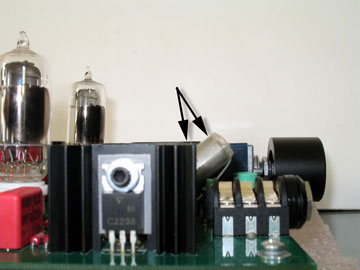Buy Boards & Parts:
www.beezar.com
www.beezar.com

The Millett Hybrid MOSFET-MAXed - VitaminQ PIO Capacitors
Sprague 196P and 96P VitaminQ PIO (Paper In Oil) Capacitors
Background -
As many of you know, the Millett MOSFET-MAX continues the long tradition of the Millett in using bypass film caps. Under certain scenarios, a small bypass cap applied in parallel across a large electrolytic can cure the issues of using an electrolytic in the signal path: high end harshness and lack of resolution. High end harshness and lack of resolution occurs in almost all electrolytics: more so in "power" caps versus "boutique" caps, but to a certain extent in both.The basic Millett, and also the MAX, MOSFET-MAX, and MiniMAX, uses Wima film caps as bypasses. |
 |
|||
|
These work very well and constitute the basic BOM. They are the economical choice of one of the "Can't Miss MOSFET-MAX Builds" in the revised Tweaks-Boutique section. Using the Wimas as bypasses can make the MOSFET-MAX a compelling amp with just power caps in the signal positions. They also help the sound of many of the boutique caps and pair very well with the Nichicon ES's, for instance, a favorite electrolytic cap for the signal positions on the MOSFET-MAX (CA2 and CA7). Pairing the Wimas with the ES's (or Nichicon Muse KZ's if case height is not an issue) is another of the "Can't Miss MOSFET-MAX Builds."
However, the Wimas retain a certain graininess and minor squeek that is slightly noticeable to the committed audiophile. In those cases, higher quality bypassing caps are desired. At the same time, the JFET-Mod MOSFET Diamond Buffers enable the MOSFET-MAX to have an extended frequency response performance that rivals many high-end amps (perhaps only limited by your choice of tubes and output caps). So, only the most linear and neutral caps should be used as bypasses, or the MOSFET-MAX's frequency response is noticeably impaired. For instance, the MOSFET-MAX's often intimidating bass is noticeably curtailed with classic "blooming mids" boutique film caps. In the cathode bypass positions by the tubes (CA9), such a cap can completely wreck the MOSFET-MAX's bass. | ||||
| Some caps live up to the hype, however, and at the same time provide an extended frequency response in the MOSFET-MAX. Vitamin Q paper-in-oil (PIO) caps have always been the preferred choice in the case of an upgraded MOSFET-MAX. Unfortunately, the genuine name-brand Sprague Vitamin Q's in the desired ratings are too large for the pads on the MAX PCB. So, they require a special technique for installation. That said, you will find the procedure for installing the genuine Sprague 0.22uf-100V, Model #196P VitaminQ's (or 96P-series 0.18uf 100V VitQ's)is even simpler than that for the K42's. (The VitaminQ caps and the Russian K42's are all available at Beezar.com.) The information, drawing, and photos below will guide you with this installation technique. Once installed, you will find that the 96P-/196P-series VitQ's are among the finest, if not the best, film cap bypasses that you could install for your MOSFET-MAX. There is literally no film cap available at this performance aand at these prices. ($2-$3 at beezar.com) |
||||
 | ||||
| ||||
Referring to the detail above and using the leads the VitQ's are born with, bend them according to the template above. It's best to start with a sharp right angle bend at the rear nipple. Pull the lead through the back pad so that the cap edge presses firmly against the board. As you do this, the lead will attain a similar shape as shown in the detail. The caps should be angled down in back, pointed up, and slightly toward center. The cap on the right side will actually fit between the back edge of the Alps pot and the right-center heat sink. |

| |||
| With both in position, they will look like a couple of battleship guns - so to speak - pointing toward the center of the front panel. (Note that the tombstone points are not used, only the two outer-most standard pads.) The leads are heavy enough that they provide some structural support, but the whole assembly is quite rigid. The trick is to pull the back lead through the bottom of the PCB until the edge of the can is resting firmly on the board. Ideally, you may want to insulate the forward lead where it bends under and down to the front pad, but it's not absolutely necessary. Also pull through the front lead. The top edge of the cap should be somewhere between 1/16" and 1/9" above the top surface of the caps. This is the recommended clearance if you are using 1" sinks and wish to install the PCB in the 3rd slot from bottom of the standard Hammond case. | ||||
| Continue to pull until they are at the desired height. If needed, remove, straighten out the leads, and try again. Since the leads are providing structural stability, try not to force the top edge of the cap down, but continue to pull thought the bottom of the board, instead. Once soldered in the position shown, they are very solid. Nothing could be simpler unless they could somehow actually fit horizontally on the pads. As you see them in the bird's-eye pic above, they are not blocking any test points or trimmers. Even if you end up a little close with this method, the top most part of the cap end is the outer edge, not the center lead with the electrical contact. | 
| |||
We heartily recommend these caps for your MAX builds using ES's or Black Gates! When bypassing with 196P-/96P-series VitaminQ's, performance with ES's can come very close to that of Black Gates. | ||||
